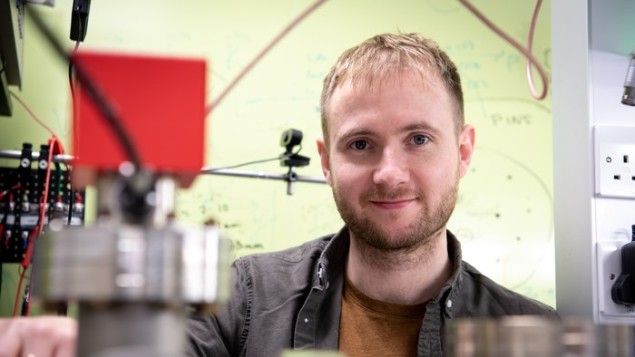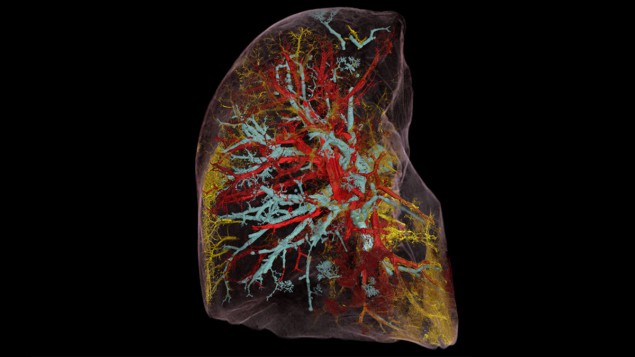Space junk – debris left by humans in space – is a growing danger for satellites and space missions orbiting the Earth. It turns out that the Moon also has space junk and in this episode of the Physics World Weekly podcast, Roberto Furfaro and Vishnu Reddy of the University of Arizona talk about the challenges of tracking lunar space junk and identifying its origins.
Αναζήτηση αναρτήσεων
Πέμπτη 31 Μαρτίου 2022
ΕΓΚΕΦΑΛΟΣ - 3 Βλαβερές + 4 Ωφέλιμες Τροφές | Ακαδημία Υγείας
ΕΓΚΕΦΑΛΟΣ - 3 Βλαβερές + 4 Ωφέλιμες Τροφές | Ακαδημία Υγείας
Τετάρτη 30 Μαρτίου 2022
6 Συνήθειες Που Καταστρέφουν Το Έντερο ΚΑΘΕ ΜΕΡΑ! | Ακαδημία Υγείας
6 Συνήθειες Που Καταστρέφουν Το Έντερο ΚΑΘΕ ΜΕΡΑ! | Ακαδημία Υγείας
Πέμπτη 10 Μαρτίου 2022
APS March Meeting set to reconnect the global physics community
APS March Meeting set to reconnect the global physics community
10 Mar 2022 Sponsored by APS March Meeting exhibitors
Thousands of physicists will once again have the opportunity to share ideas and discuss their latest results at the March Meeting of the American Physical Society
Two years ago, the American Physical Society (APS) was forced to cancel its annual March Meeting at the last minute due to the escalating COVID-19 pandemic. For the first time since then, the APS will once again convene the largest scientific conference for the global physics community, with thousands of delegates expected to converge in Chicago, Illinois, from 14 to 18 March 2022.
10 ΥΠΕΡΤΡΟΦΕΣ Που Καθαρίζουν Το Συκώτι & Μειώνουν Τον Ρίσκο Παθήσεων! [ΠΟΛΥ ΣΗΜΑΝΤΙΚΟ]
10 ΥΠΕΡΤΡΟΦΕΣ Που Καθαρίζουν Το Συκώτι & Μειώνουν Τον Ρίσκο Παθήσεων! [ΠΟΛΥ ΣΗΜΑΝΤΙΚΟ]
Κυριακή 6 Μαρτίου 2022
‘Coherent optical engineering’ turns opaque material temporarily transparent
‘Coherent optical engineering’ turns opaque material temporarily transparent
28 Feb 2022 Isabelle Dumé

Ultrashort pulses of light can dramatically alter the electronic and magnetic properties of certain materials. Indeed, such pulses have already been used to modify band gaps in graphene and topological insulators.
Magnetic ‘stop sign’ helps songbirds return to breeding sites
Magnetic ‘stop sign’ helps songbirds return to breeding sites
04 Mar 2022 Isabelle Dumé

Migrating birds use information extracted from the Earth’s magnetic field to target the same breeding grounds year after year, with the field’s inclination angle, in particular, acting as a “stop sign” telling them they have reached their destination. This conclusion, based on a new analysis of data obtained by attaching metal rings to the legs of birds and then tracking their movements, adds to a growing body of knowledge about field-based navigation in migratory animals.
Ultracold triatomic molecules herald a new frontier for the three-body problem
Ultracold triatomic molecules herald a new frontier for the three-body problem
16 Feb 2022

Researchers in China have found strong evidence of ultracold triatomic molecules forming within a mixture of ultracold atoms and diatomic molecules. The result, if confirmed, would provide an ideal pathway to studying chemical reactions on an atomic scale, and could even allow physicists to perform quantum-mechanical simulations of the notoriously difficult three-body problem.
New system could control quantum experiments in space
New system could control quantum experiments in space
01 Mar 2022

A scalable and flexible system for the remote monitoring of quantum experiments in noisy and unpredictable environments has been created by researchers in the UK. Thomas Barrett and colleagues at the University of Sussex used the latest sensing, machine learning and database technologies to create and maintain multiple quantum-related experiments involving ultracold atoms.
Tracking space junk around the Moon, one teacher’s struggle to correct textbook errors
Tracking space junk around the Moon, one teacher’s struggle to correct textbook errors
03 Mar 2022 Hamish Johnston
Battery analysis underpins future gains in performance and lifetime
Battery analysis underpins future gains in performance and lifetime
28 Feb 2022 Sponsored by TA Instruments
Thermal measurements that reveal the complex electrochemical behaviour inside a lithium-ion battery are crucial for designing improved energy-storage devices that last for longer
The revolution in mobile technologies has been enabled in large part by advances in rechargeable lithium-ion batteries, allowing more powerful mobile devices with super-sized screens to operate for longer.
Panel calls on physicists to ‘shelve’ notion of Japan hosting the International Linear Collider
Panel calls on physicists to ‘shelve’ notion of Japan hosting the International Linear Collider
01 Mar 2022 Michael Banks

Physicists backing Japan to build the ¥600bn ($5bn) International Linear Collider (ILC) must re-evaluate their plans and “shelve” the question of the country hosting the proposed next-generation particle collider. That is the stark message to emerge from a panel of senior Japanese officials who have examined progress made towards realizing the ILC.
Experts debate the possible paths to human-like AI
Experts debate the possible paths to human-like AI
01 Mar 2022 Sponsored by IOP Publishing
A stellar line-up of computer designers and bioengineers will go head-to-head in a virtual debate that will explore whether the biological brain should influence the design of future AI systems
Scientists and engineers continue to push the boundaries of what can be achieved with artificial intelligence (AI), with the last few years seeing impressive gains in areas such as speech recognition and natural language processing.
Drawing up a ‘Google Earth’ of the human body
Drawing up a ‘Google Earth’ of the human body
02 Mar 2022
Taken from the March 2022 issue of Physics World. Members of the Institute of Physics can enjoy the full issue via the Physics World app.
Scientists are seeing the human body in a new light, thanks to a unique synchrotron-imaging technique, as Jon Cartwright discovers

In this age of information, we expect to have knowledge at our fingertips. If we’re looking to obtain a first impression of someone, many of us head straight to their social-media pages. If we want to understand a new topic, we don’t buy a textbook – most of the basics are waiting for us on Wikipedia. And if we want to explore a new city, we can do much of it by moving around in Google Earth. Information that was once costly or exclusive is now free to all.
Experimental evidence found for long-distance intermolecular forces
Experimental evidence found for long-distance intermolecular forces
28 Feb 2022

Experimental evidence of long-range attractive forces between cellular proteins has been obtained by researchers in France more than 50 years after the idea was first proposed. The forces are mediated by electromagnetic radiation, and they could explain how molecules find their targets inside the crowded interiors of living cells.
The Human Organ Atlas: a ‘Google Earth’ for our bodies
The Human Organ Atlas: a ‘Google Earth’ for our bodies
02 MarJames Dacey
Wouldn’t it be amazing to have a tool like Google Earth but for the human body, where you could zoom in from a full organ down to its cellular structures? That’s now becoming a reality thanks to the Human Organ Atlas project, and physics is key to this innovation. This short videos explains how the Human Organ Atlas project emerged from the COVID-19 pandemic and how it could help medical scientists in a range of clinical contexts.
Quantum sensor could detect SARS-CoV-2
Quantum sensor could detect SARS-CoV-2
26 Feb 2022 Isabelle Dumé

A quantum sensor based on nitrogen-vacancy centres in diamond could be used to detect viruses like SARS-CoV-2, which is responsible for the current COVID-19 pandemic. This is the finding of researchers at the University of Waterloo in Canada, who performed detailed mathematical simulations to show that the new technique would make it faster and cheaper to detect viruses with high accuracy.
Controlling cells with sound: scientists pioneer sonogenetics
Controlling cells with sound: scientists pioneer sonogenetics
04 Mar 2022

A US-based research team has developed a new “sonogenetic” technique to activate and control mammalian cells with sound – potentially paving the way for innovative non-invasive versions of deep brain stimulators, pacemakers and insulin pumps. So, what exactly is sonogenetics? What are its potential clinical advantages? And what are the next steps for the research team?
Skin tone impacts photoacoustic measurements of blood oxygenation
Skin tone impacts photoacoustic measurements of blood oxygenation
01 Mar 2022

Pulse oximeters, which measure the percentage of oxygen in the blood, can be used as part of clinical decision-making to triage patients, adjust supplemental oxygen levels, and more. In 2020, researchers analysed tens of thousands of blood oxygenation measurements collected from thousands of patients.
Whistler waves disappear close to the Sun
Whistler waves disappear close to the Sun
02 Mar 2022 Isabelle Dumé

A close analysis of data from NASA’s Parker Solar Probe has revealed that electromagnetic “whistler waves” – so named because early radio operators mistook these eerie, descending sounds for a person whistling – are unexpectedly absent from certain regions of the Sun’s upper atmosphere.
Εγγραφή σε:
Σχόλια (Atom)


